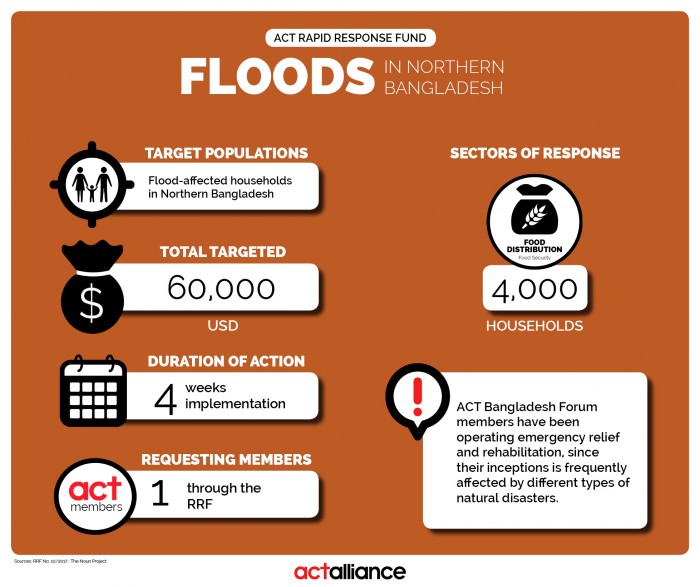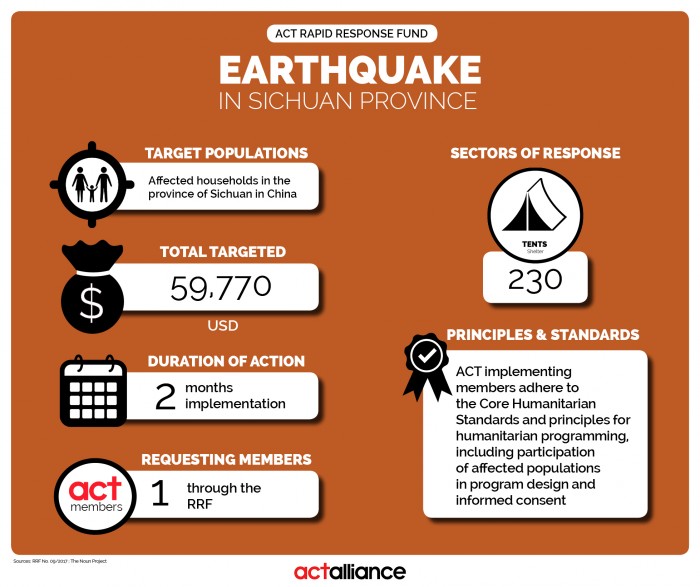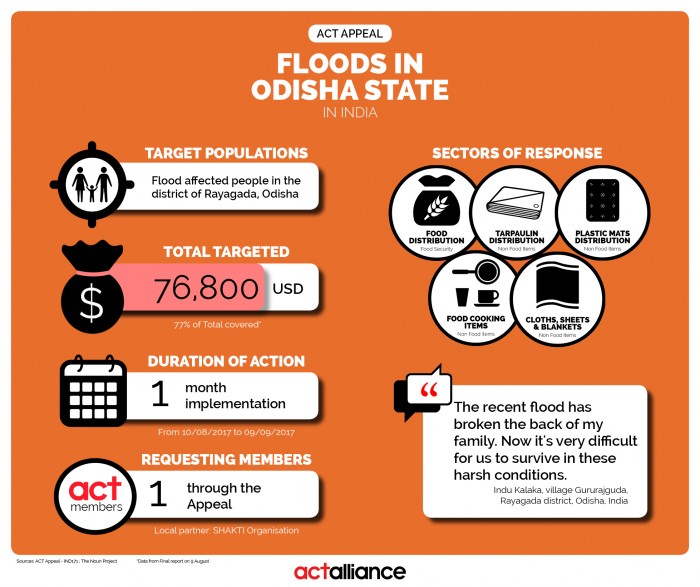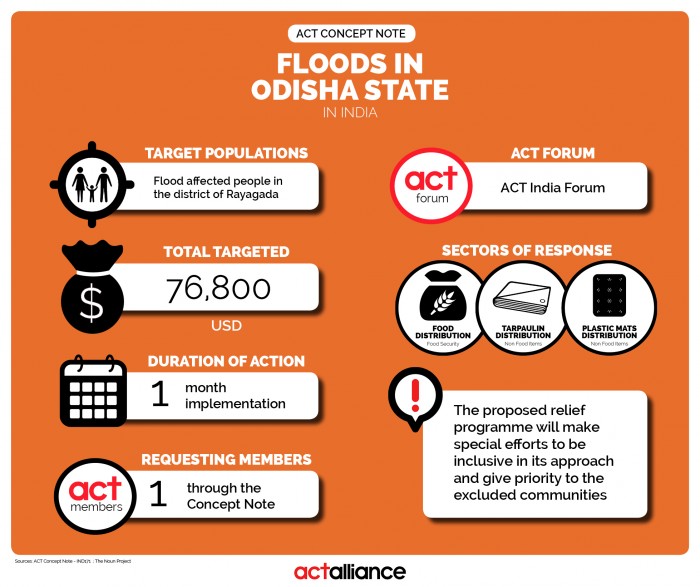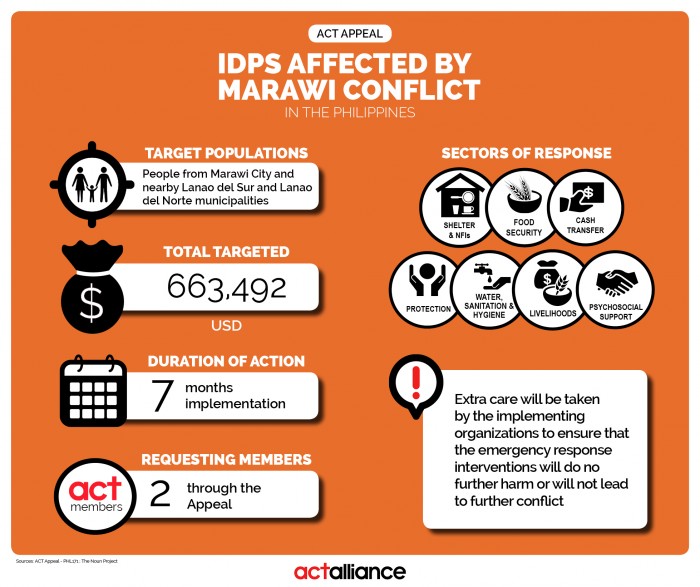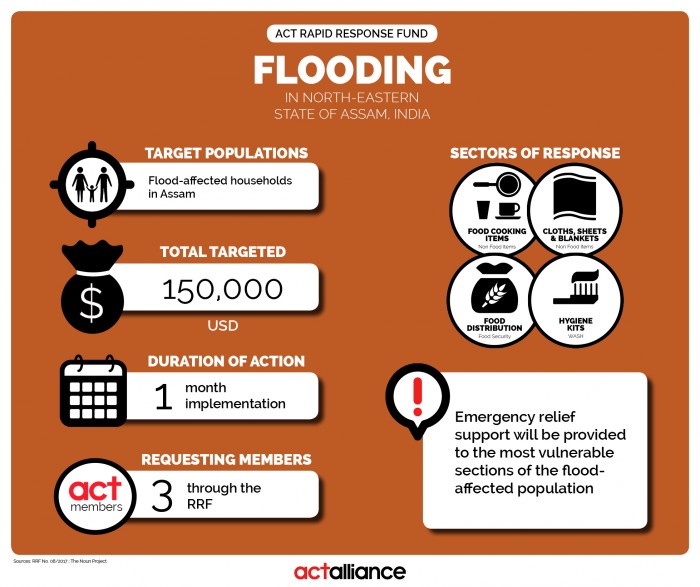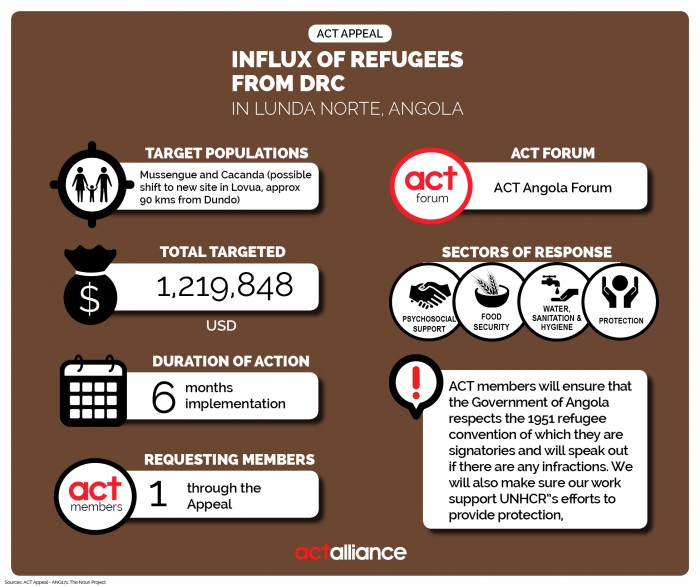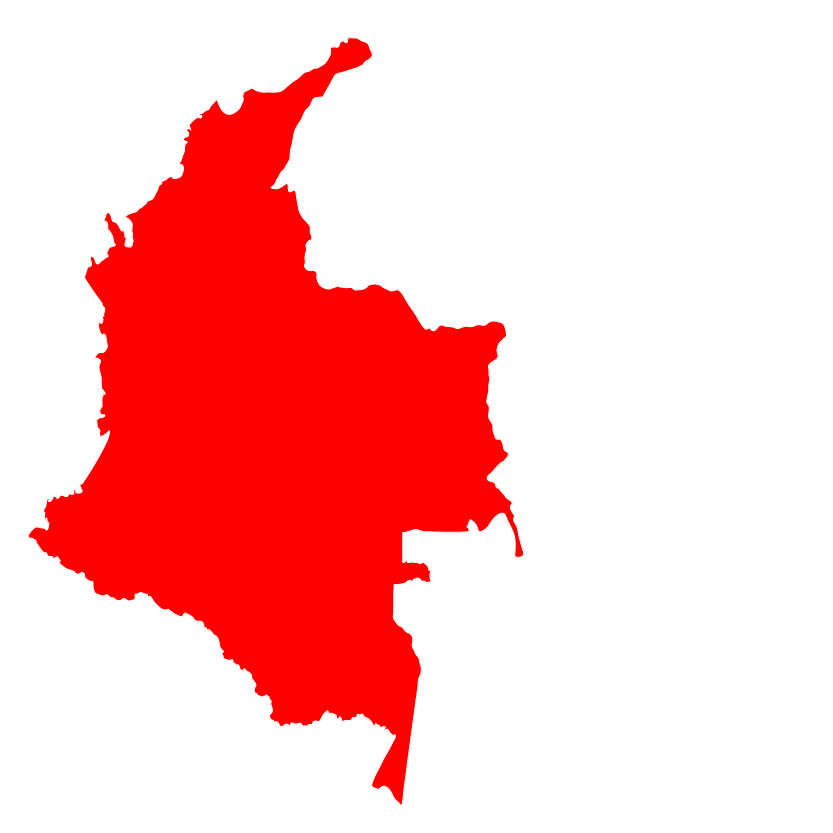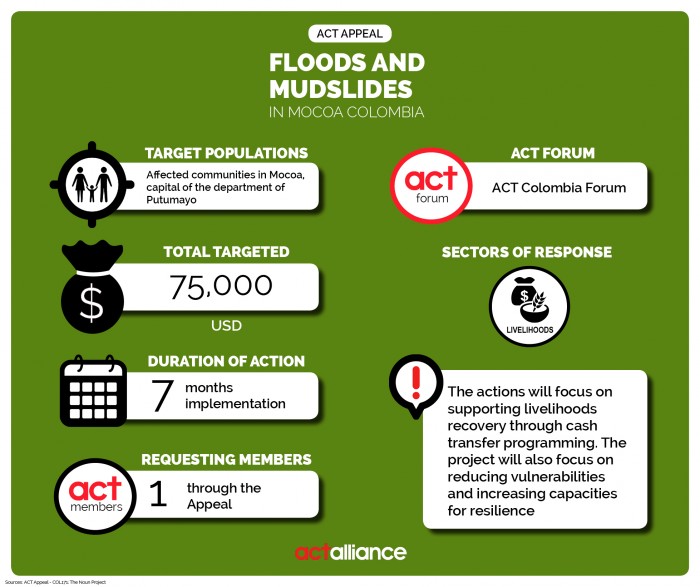Bangladesh: Emergency response to the Floods in the Northern region – No.RRF 10/2017

Severe flooding due to monsoon rains and rain waters from the Indian states in the north of Bangladesh inundated 22 of the 64 districts by August 15, 2017. According to National Health Crises Management Centre’s control room; death toll has risen to 89 and approximately 1.7 million people have been affected by this flooding. About 121,170 hectares of cultivated land have been severely affected. Around 1031 primary schools are closed.
Flood-affected households have taken shelters on higher grounds, some are marooned and disconnected due to this flooding. Roads and railway communication between northern districts and Dhaka (capital) remain disconnected. Flood waters are flowing downstream and new areas in central part of the country are being affected. Affected people have taken shelters along the highways, road sides, embankments or in schools.
Bangladesh Government has already allocated 11.66 million BDT (USD $ 0.15 million) and 3,607 MT of rice to 22 flood-affected districts. Armed forces have been assigned to provide rescue services along with embankment repair and food distribution. Affected communities are also involved in repairing breached embankments and rescue operations.
RRFs_Bangladesh_Floods in the Northern region_No.RRF 10/2017

China: Emergency response to the earthquake in Sichuan Province – No.RRF 9/2017

A 7.0-magnitude earthquake jolted Jiuzhaigou, a popular tourist destination in southwest China‘s Sichuan province on August 8th, 2017. So far, At least 19 people were killed and 343 injured after the earthquake, according to the information office of the provincial government. Around 1680 houses from 17 townships were collapsed or destroyed. The situation and extent of damage of the disaster in still being assessed.
ACT member Amity Foundation is improving the affected population’s access to temporary emergency shelter by providing tents, via a Rapid Response Fund of 59,770 USD.
RRFs_China_Earthquake in Sichuan Province_No.RRF 09/2017

India: Emergency response to the Floods in Odisha – IND171

The state of Odisha in India has been witnessing incessant rainfall from 15 July 2017, due to which flash floods occurred in river Nagabali and Kalyani of Rayagada district. More than 28,000 people in 50 villages under Rayagada Block and 20 villages under Kalyansinghpur Block have been affected. Five persons have been injured due to a wall collapse in Rayagada district.
The ACT India Forum is planning to respond to this emergency via ACT member Church’s Auxiliary for Social Action (CASA). The 76’800 USD target project is aimed at providing relief assistance in the form of Food and Shelter/Non Food Items to the flood-affected people in the district of Rayagada, in order to address many of their survival needs.
The appeal document can be accessed below
Appeals_India_Floods in Odisha_IND171

India: Emergency response to the Floods in Odisha – IND171 (Concept Note)

The state of Odisha in India has been witnessing incessant rainfall from 15 July 2017, due to which flash floods occurred in river Nagabali and Kalyani of Rayagada district. More than 28,000 people in 50 villages under Rayagada Block and 20 villages under Kalyansinghpur Block have been affected. Five persons have been injured due to a wall collapse in Rayagada district.
The ACT India Forum is planning to respond to this emergency via ACT member Church’s Auxiliary for Social Action (CASA). The 76’800 USD target project is aimed at providing relief assistance in the form of Food and Shelter/Non Food Items to the flood affected people in the district of Rayagada, in order to address many of their survival needs.
Please click below to see the Concept Note.
Concept Notes_India_Floods in Odisha state_IND171
As part of the revision of the ACT Alliance Humanitarian Response Mechanism, the “Preliminary Appeal” is replaced by the “Concept Note”, a shorter more concise document which summarizes the proposed ACT response and emphasizes collaboration amongst the ACT members. For further information on the Revised Humanitarian Response Mechanism, please refer to its online toolkit : https://actlearn.org/course/view.php?id=236
Philippines: Emergency response to the Marawi crises – PHL171

On May 23, 2017, the Armed Forces of the Philippines (AFP) launched a military and law enforcement operation in Marawi City, Lanao del Sur province in Mindanao, in pursuit of Abu Sayyaf leader Isnilon Hapilon, who was believed to be the designated leader of the Islamic State in Iraq and Syria (ISIS) in the Philippines. His forces fought back with reinforcement from the Maute Group, a local militant group that has pledged its allegiance to the ISIS. This led to a firefight between the AFP and the Islamic extremists, which has displaced a total of 353,358 persons or 74,981 households from the 96 barangays of Marawi City and 20 municipalities of Lanao del Sur. Of the total affected population, 4,086 households/18,294 persons are currently staying in 78 evacuation centres while 70,895 households/335,064 persons are staying with their relatives tracked in 7 Regions (NDRRMC, July 5, 2017).
Latest data from the government (Ibid) revealed that there are 418 reported dead and 209 reported missing, though more are expected because of the continuous airstrikes and ground assaults from the opposing parties. The insecure situation has not allowed any detailed damage assessments to take place; however, extensive damages are expected on homes, livelihoods and infrastructures, including academic and religious structures. The President of the Philippines declared Martial Law in the Mindanao group of islands on the same day of the conflict, while Marawi City declared the State of Calamity on May 25, 2017.
Appeals_Philippines_Marawi crises_PHL171

India: Emergency response to the floods in North-Eastern State of Assam – No.RRF 08/2017

There have been heavy torrential rains since 2nd July 2017 in the North-Eastern state of Assam in India. The rains have continued and the floods have intensified in the last 48 hours. 24 districts of Assam have been affected during this current phase of floods. A population of 1,718,135 has been badly affected by current floods and is struggling with the worsening flood situation in the state.
According to a report by the Assam Disaster Management Authority (ASDMA), lately, 7 people were killed in various flood-related incidents in Goalpara, Jorhat and Lakhimpur districts. In Lakhimpur, 3 people were killed by drowning and landslides. The toll in the Assam flood has risen to 44 with five more deaths being reported on Wednesday, July 12, 2017. Approximately 1 million animals, including poultry have been affected and 1,652 houses have been damaged during this flood. Large scale destruction of infrastructure, cropland and wildlife has been reported from different areas. 2,498 villages with more than 140,837 hectares of standing crops have been badly affected due to floods. The flood water has caused widespread destruction in the world-famous Kaziranga National Park, where more than 560 animals, including 14 rhinos, were killed. Road services have been affected at 2,847 places while railway tracks, damaged by landslides in the Lumding-Badarpur Railway division, were yet to be restored. The situation is likely to worsen in coming days as the water level in major rivers is continually rising above the danger level and more rainfall has been predicted by the Meteorological Department of India.
RRFs_India_Floods in North-Eastern State of Assam_No.RRF 08/2017

Palestine: Emergency response to Gaza and West Bank Crises – PSE171 (Follow-on Appeal)

The political, economic and social context in the Occupied Palestinian Territory (OPT) did not change much during 2016 and the first part of 2017. Poverty, hardship condition, psycho-social problems and food shortage are still dominating the overall picture of the situation in Gaza. The ongoing siege imposed on the Gaza Strip since June 2006 is still contributing to the deterioration of health status and negatively affecting the provision of health services.
The United Nations Office for the Coordination of Humanitarian Affairs (UN-OCHA) conducted a humanitarian impact assessment of the blockade on the Gaza Strip in November 2016, and has repeatedly described the situation as a chronic emergency and a protracted human dignity crisis. The blockade and three major escalations of hostilities in the last six years have inflicted large-scale destruction on Gaza’s economy, productive assets and infrastructure. A chronic energy crisis, with power outages reaching 12-16 hours a day, also impairs service delivery, students’ educational activities, the function of hospitals and medical equipment, as well as the operation of more than 280 water and wastewater facilities.
ACT Alliance, through the ACT Palestine Forum (APF), has been consistently working on the ground with the most vulnerable people. This Follow-on Appeal proposes to run Cash Relief, Job-Creation, Psycho-social Support, Health, Education, and Agriculture programs.
Appeals_Palestine_Gaza and West Bank Crises_PSE171
Sri Lanka: Emergency response to the floods and Landslides – No. RRF 07/2017

Incessant heavy monsoon rains (as high as 553 mm) starting on May 26 have caused floods and landslides in many parts of Sri Lanka (15 districts). As of 1st June 2017, 206 people are reported dead, while 92 are missing; so far, over 658,490 people are affected. Further, 1,713 houses were fully destroyed and around 9,294 houses partially damage[1]. Most numbers of damages to lives and property are reported in Southern and Western part of the country: from Galle, Matara, Kalutara, Gampaha, Colombo and Ratnapura districts. In addition, Approximately 68,734 people were relocated to 365 safe locations.
ACT Sri Lanka Forum through The National Christian Council of Sri Lanka (NCCSL) plans to respond to this emergency through ACT Rapid Response Fund (RRF) at the amount of 60,000 USD, by providing Food Security, Non-Food Items, Health, and WASH programs.
[1] As per the situation report issued by DMC on 29-05-2017 at 7.00 hrs: http://www.dmc.gov.lk/index_english.htm
RRFs_Sri Lanka_Floods and Landslides_No.RRF 07/2017
Angola: Emergency response to the influx of refugees from DRC in Lunda Norte – ANG171 (Preliminary Appeal)

Ongoing armed conflicts between the DRC government forces and the Kamuena Nsapu militia faction in Lunda Norte Province have triggered large displacements. As of the 13th of April, it was reported that a total of 11,051 refugees had arrived from the DRC and were settling in two camps. These numbers continue to rise as it is estimated that there is an additional 300-400 refugees arriving each day.
Tensions on both sides of the border are high. Still, the Angolan authorities assure that the border is not closed, but that the commercial movements are being closely monitored and the usual local market closed. The government sent a multi-sector team to assess the situation. The government of Angola has to date not declared an emergency, as the governments of Angola and DRC are analysing the situation and hope voluntary repatriation to DRC will be possible within one month or so.
In the meantime, the situation in the camps is dire as the access to basic services is very limited. The situation is further compounded by the fact that the camps are over-crowded causing a lack of shelter, food & NFIs, and poor sanitation. Furthermore, protection issues are frequent as there are cases of unaccompanied minors and violation of human rights, particularly with regards to the risk of repatriation.
ACT Angola Forum through Lutheran World Federation(LWF) plans to respond to the ongoing crisis and provide basic needs such as shelter, WASH, food and NFIs, child rights protection, human rights and health care assistance for life-saving. UN Agencies are advocating for an official emergency declaration, in order to facilitate a more comprehensive response.
Preliminary Appeals _Angola_DRC Refugee Influx Crisis in Lunda Norte _ANG171

Colombia: Emergency response to the floods and mudslides in Mocoa – COL171

130 mm of rain fell in the city of Mocoa in southwest Colombia between 23:00 on 31 March and 01:00 on 1 April, causing the flooding of the Mocoa, Mulato, and Sangoyaco Rivers, and several mudslides throughout Mocoa. These rainfalls amount to one-third of the average for an entire month for the area. At least 332 people have died, 332 were injured, 106 remain missing. About 17,500 of the up to 70,000 living in Mocoa have been affected by the floods and mudslides, and 3,417 are displaced. 36 of 37 neighbourhoods of Mocoa have been affected. Areas in southern Mocoa have been the hardest hit, and six are completely destroyed. The registration of victims has been closed, with over one hundred persons still counted as “disappeared.” Now the efforts focus on restoring services and normality to the capital of Putumayo Department. Thousands of families remain in precarious living conditions, many of them in the 13 formal shelters established by the authorities. Authorities are ensuring that supplies and services are reaching affected populations, both in the 13 formal shelters set up and in the spontaneous settlements in the outskirts of Mocoa.
The ACT Alliance Colombia forum Member, LWF in coordination with a local partner is responding to the emergency and have agreed to address the response to livelihoods restoration.
Appeals_Colombia_Floods and Mudslides in Mocoa_COL171


